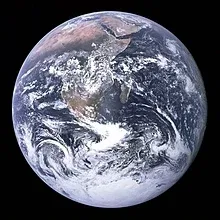What is earth?

Earth is the planet we live on. It is the third planet from the Sun. It is the only planet known to have life on it. The Earth formed around 4.5 billion years ago.
We all know that earth is plannet and it also revolves arround the sun and as a result of it days and nights occour .
What is Ga and Ma in the language of science?
Ga: means billion years ago
Ma:means million years ago
Earth formed arround 4.54 Ga years ago approximately one third the age of universe.
What is Theia?
It is most important term.Theia is the planet by which earth hit and as a result universe formed.
The Hadean eon represents the time before a reliable (fossil) record of life; it began with the formation of the planet and ended 4.0 billion years ago. The following Archean and Proterozoic eons produced the beginnings of life on Earth and its earliest evolution. The succeeding eon is the Phanerozoic, divided into three eras: the Palaeozoic, an era of arthropods, fishes, and the first life on land; the Mesozoic, which spanned the rise, reign, and climactic extinction of the non-avian dinosaurs; and the Cenozoic, which saw the rise of mammals. Recognizable humans emerged at most 2 million years ago, a vanishingly small period on the geological scale.
The earliest undisputed evidence of life on Earth dates at least from 3.5 billion years ago,[7][8][9] during the Eoarchean Era, after a geological crust started to solidify following the earlier molten Hadean Eon. There are microbial mat fossils such as stromatolites found in 3.48 billion-year-old sandstone discovered in Western Australia.[10][11][12] Other early physical evidence of a biogenic substance is graphite in 3.7 billion-year-old metasedimentary rocks discovered in southwestern Greenland[13] as well as "remains of biotic life" found in 4.1 billion-year-old rocks in Western Australia.[14][15] According to one of the researchers, "If life arose relatively quickly on Earth … then it could be common in the universe."[14]
Photosynthetic organisms appeared between 3.2 and 2.4 billion years ago and began enriching the atmosphere with oxygen. Life remained mostly small and microscopic until about 580 million years ago, when complex multicellular life arose, developed over time, and culminated in the Cambrian Explosion about 541 million years ago. This sudden diversification of life forms produced most of the major phyla known today, and divided the Proterozoic Eon from the Cambrian Period of the Paleozoic Era. It is estimated that 99 percent of all species that ever lived on Earth, over five billion,[16] have gone extinct.[17][18] Estimates on the number of Earth's current species range from 10 million to 14 million,[19] of which about 1.2 million are documented, but over 86 percent have not been described.[20] However, it was recently claimed that 1 trillion species currently live on Earth, with only one-thousandth of one percent described.[21]
The Earth's crust has constantly changed since its formation, as has life since its first appearance. Species continue to evolve, taking on new forms, splitting into daughter species, or going extinct in the face of ever-changing physical environments. The process of plate tectonics continues to shape the Earth's continents and oceans and the life they harbor. Human activity is now a dominant force affecting global change, harming the biosphere, the Earth's surface, hydrosphere, and atmosphere with the loss of wild lands, over-exploitation of the oceans, production of greenhouse gases, degradation of the ozone layer, and general degradation of soil, air, and water quality.
contest held by @cmp2020
Good concept raelly
Downvoting a post can decrease pending rewards and make it less visible. Common reasons:
Submit